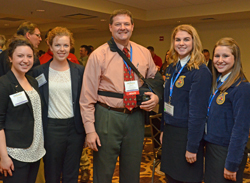 Looking for leadership from young agricultural producers in business and sustainability, Bayer CropScience is seeking nominations for the 2015 Young Farmer Sustainability Award program.
Looking for leadership from young agricultural producers in business and sustainability, Bayer CropScience is seeking nominations for the 2015 Young Farmer Sustainability Award program.
“Young men and women across the United States are solving great agricultural challenges by implementing innovative, sustainable solutions on their farms,” said Jim Blome, president and CEO of Bayer CropScience North America. “From making small-scale system tweaks to wholesale operational and marketing shifts, we hear stories every day from farmers who are working 24/7 to make their farms more sustainable by the day.
“The Young Farmer Sustainability Award recognizes and celebrates the next generation of exceptional growers who will lead this industry into the future—a generation that is critical to meeting the demands of a growing population and protecting our planet.”
Farmer and ranchers age 40 and under who receives at least half their income from farming and farm-related ventures are eligible to apply. More information is available here.








